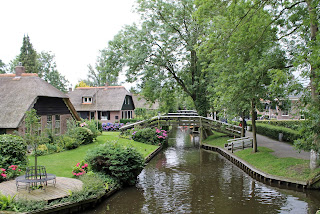July 23-26
We are now in one of the three Northern provinces in the Netherlands, named Drenthe. Christie's brother Kees lives here, in the village of Diever, with his wife Wietske. They bought the home of the former mayor of Diever, which no longer needs a mayor because Diever is no longer an independent community. The Netherlands has gone very far in consolidating municipalities to eliminate duplication, cost and waste. So has Diever with a number of other, formerly independent towns and villages, become part of the municipality of Westerveld (an entity not previously found on the map). The townhall for Westerveld is newly built and located in Diever.
This part of Holland is another place of serenity and tranquility. It is amazing how many oases of natural beauty and peace are still available. For the second time since we arrived in Holland have we been on a long bike ride. The weather was just perfect, partly sunny and about 65 degrees, after a ferocious storm came through late yesterday and brought down trees everywhere. In contrast to the US, such event does not trigger power outages here, because all power lines have long ago been moved underground.
The coastal areas of Holland took the brunt of the storm of July 25, with wind gusts in excess of 100km/hr. We witnessed the storm coming in over the water at Stavoren, on the edge of the IJsselmeer, where the classic Frisian sailing race 'Skutjesilen' had to be canceled because of the weather conditions. Apparently, according to the media, we experienced the second fiercest July storm ever recorded in the Netherlands. Braving the conditions, we dedicated our day of July 25 to a tour (by car) of some of the island cities of the former 'Zuiderzee' (now IJsselmeer) which are, as a result of the land reclamation, surrounded by newly gained land of the 'Noordoostpolder' and 'Flevoland'. It is a unique phenomenon to see these age old island cities, with their harbors still intact, embedded in the flattest, newest land imaginable. We visited Stavoren, Urk, Lemmer and Vollenhoven. They are all centuries old and of unparalleled charm.
Drenthe is home to the largest collections of 'hunebedden', ceremonial grave sites, dating back more than 5,000 years. Not quite as big or imposing as 'Stone Hedge', they are nevertheless important archaeological features in the landscape. Drenthe is lightly populated with little more than 450,000 inhabitants in the total province. It was traditionally a poor area, since the sandy soil was not very productive for agricultural purposes. Large parts of the landscape are therefore unspoiled, heavily wooded and interspersed with moorland. The features of the landscape are sculpted by the retreating glaciers of the Ice Age, leaving behind morenes, huge boulders which became the building blocks for the 'hunebedden'. Biking around in Drenthe you have no idea that you are in the most densely populated country in Europe. The economy is part agricultural, but mostly recreational. Little industry and few jobs, which causes the young to leave for the big cities in Holland and the old to move in or hang around. Forgetting the weather it is ideal retirement terrain.
West of Drenthe lies the province of Friesland, the only province with its own language (Frisian) which is distinctly different from Dutch. The language makes a cultural revival and appears on most signs and publications, but is not a compulsory faculty in the Frisian schools. In Friesland we visited Stavoren, which we reached by way of the Ice Age created sandy ridge named 'Gaasterland' in an otherwise low lying land of lakes, grassland and waterways. Friesland is the land of sailing (in the summer) and ice skating (in the winter). Gaasterland is breathtakingly beautiful, with only a few small villages named Nijemardum, Aldemardum, Rijs en Murns. From there, the fishing village of Stavoren is only a stone-throw away.
Our last stop on the day of the storm was in Giethoorn, called 'Venice of the North', where the prevailing means of transportation is the boat. It is a major tourist attraction offering 1 hour and 2 hour boat rides on man powered or battery powered boats (gasoline and diesel engines are outlawed here in order not to break the silence and protect the air).
We will now be leaving the mainland for the barrier island of Vlieland. It will take a ferry ride of an hour and a half from the Frisian town of Harlingen. We have to leave our cars behind. No automobiles permitted on the island other than for a few license holders who are permanent residents of the island. The forecast is dim: rain and cold, but anticipation is great. This is the epitome of tranquility in the Netherlands. In theory, it is a great ground for surf fishing. We will see. I will report from there.




No comments:
Post a Comment